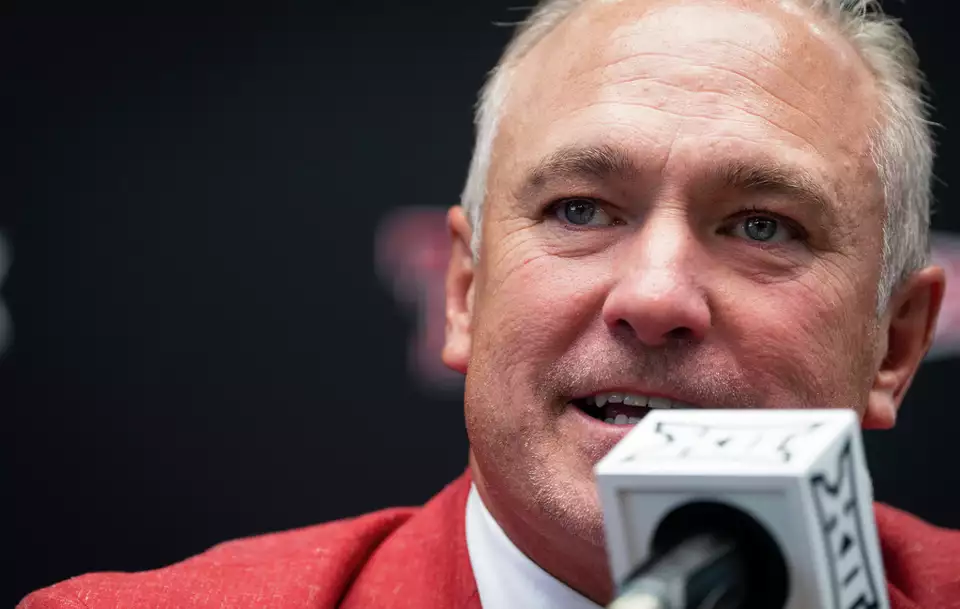By Mike Finger | San Antonio Express-News (SAEN), 2025-07-05 15:45:28
由生成式人工智能翻译,译文内容可能不准确或不完整,以原文为准。
七年前,一个厌倦了无法赢得冠军的大学橄榄球项目,决定“买”下一个冠军。
多亏了得克萨斯州的石油繁荣,这所大学拥有财大气粗的捐赠者,手握数百万闲置资金。它有一个计划,通过将这些钱交给一个能让其所谓的业余球队变得更好的人,从而利用这些资金。而由于那个人恰好是一名教练,这项计划完全合法。
于是, 德州农工大学 (Texas A&M) 给 吉姆博·费舍尔 (Jimbo Fisher) 开出了大学橄榄球史上最大的合同,然后坐等胜利滚滚而来。
当然,事情并没有那样发展,但很难指责农工队(Aggies)的尝试。尽管他们被外界嘲讽连连,但很少有人指责他们试图扼杀我们所熟知的这项运动。
在此很久之前,大学橄榄球就已经被金钱主宰。它变成了一个价值数十亿美元的产业,学校以这种方式对待它再自然不过。
那么,如今又有一所拥有石油财富校友并怀揣宏伟梦想的大学项目,正在尝试2025年版的“购买荣光”呢?
德克萨斯理工大学 (Texas Tech) 的计划不保证奏效。
但它并不比农工大学的尝试更离谱。
诚然,这些数字看起来触目惊心。一份总额510万美元的三年保障合同?为一个仍在高中就读的青少年进攻线球员?
据曼斯菲尔德湖岭高中(Mansfield Lake Ridge)进攻截锋 费利克斯·奥乔 (Felix Ojo) 的经纪人本周告诉ESPN,这是真的。这位身高6英尺7英寸(约2.01米)、体重285磅(约129公斤)的五星级新秀于周五宣布承诺加盟德克萨斯理工大学,拒绝了包括德克萨斯大学(Texas)、密歇根大学(Michigan)和俄亥俄州立大学(Ohio State)在内的豪门邀请,签下了大学橄榄球新营收分成时代最大的一笔经济合同。
上个月联邦和解协议获得司法批准后,从7月1日起,大学直接向球员支付报酬成为合法行为。根据和解协议的条款,每所学校每年最多可向所有体育项目的运动员分配2050万美元——约占四大联盟(Power Four)收入的22%。其中大部分预计将用于橄榄球和男子篮球,这两个项目是创收最多的运动。
但红突袭者队(Red Raiders)——他们在31年前西南联盟(Southwest Conference)冠军五校并列以来,就没有再赢得过分区冠军;自2009年以来,也从未进入过全国前25名——在去年冬天就已经开始了这场烧钱狂潮。
在联邦和解协议之前,大学附属的集体组织(collectives)与球员签订关于其姓名、肖像和形象使用权(NIL)的协议是没有任何限制的。据ESPN报道,德克萨斯理工大学上赛季结束后花费了超过1000万美元,从NCAA转会门户(transfer portal)引进了17名球员。
随着奥乔的加入——他在247Sports综合排名中被列为全国第七好的总招募球员——红突袭者队的阵容变得更加昂贵。
如果最糟糕的情况,仅仅是几位富有的捐赠者最终发现他们冲动投资的钱没有物有所值呢?
嗯,这在大学橄榄球界也不是第一次发生。
你大可以去问问那些为被解雇教练支付数百万美元以使其不执教的数十个大学项目。问问农工队就知道了,他们曾以一份从2018赛季开始的10年、7500万美元的合同,将费舍尔从 佛罗里达州立大学 (Florida State) 挖走,随后又将这份承诺延长了四年,总额达到近9500万美元。
农工大学于2023年解雇了费舍尔,此前他在六个赛季中取得了45胜25负的战绩,没有赢得任何分区冠军,仅一次进入前15名。为了让他离开,农工队在2024年春季一次性支付了他2660万美元,但这并非全部。今年,他们还欠他720万美元,让他不用招募球员、不用指挥战术、也不用发表演讲。明年,他们又欠他720万美元,让他可以钓鱼、打鹌鹑,或者在Netflix上刷交友节目,抑或做任何他喜欢的事情。信不信由你,他们有义务在2031年前每年支付他720万美元。
这里的教训并非是大学橄榄球项目负担不起这些。
教训是:他们有能力承担。
所以,请原谅我们没有对一所大学每年向一名未经检验、可能不值这个价的球员开出170万美元感到敲响警钟。
那些巨富捐赠者本可以找到更好的方式来利用他们的钱,从而更好地服务他们的大学、社区或他们周围的世界吗?毫无疑问。
德克萨斯理工大学是否很有可能继续疯狂烧钱,最终仍然离全国冠军或大学橄榄球季后赛(College Football Playoff)资格相去甚远?是的。
但如果非要等到一名青少年线卫荒唐地变得富有,才让你意识到这整项事业有多么荒谬?
恕我直言,亲爱的读者:你来晚了。

Texas Tech head coach Joey McGuire takes questions at the NCAA college football Big 12 Media Days in Arlington, Texas, Thursday, July 13, 2023. (Sara Diggins/Austin American-Statesman via AP)

NORMAN, OK - OCTOBER 22: Offensive lineman Deveric Gallington #66 of Texas Tech celebrates with wide receiver Alex Torres #86 after Torres’ reception for a touchdown in the first half against the Oklahoma Sooners October 22, 2011 at Gaylord Family-Oklahoma Memorial Stadium in Norman, Oklahoma. Texas Tech won 41-38. (Photo by Brett Deering/Getty Images)
点击查看原文:Can college football glory be bought? Texas Tech isn't first to try
Can college football glory be bought? Texas Tech isn’t first to try
Seven years ago, a college football program sick and tired of not winning championships decided to buy one.
Thanks in part to a Texas oil boom, the university had fat-cat donors with millions of spare dollars lying around. It had a plan to use those millions by passing them on to a guy who could make its team of supposed amateurs better. And because that guy happened to be a coach, this plan was completely legal.
So Texas A&M gave Jimbo Fisher the largest contract in college football history, and waited for the victories to start rolling in.
It didn’t work out that way, of course, but it was hard to fault the Aggies for trying. And even though plenty of jokes were made at their expense, few accused them of trying to kill the sport as we knew it.
Long before then, college football had been ruled by money. It turned into a billion-dollar business, and it was only natural that schools would treat it that way.
And now that another program with oil-wealthy alumni and dreams of grandeur is attempting the 2025 version of buying glory?
Texas Tech’s plan isn’t guaranteed to work.
But it’s no more outrageous than A&M’s attempt.
Sure, the numbers look jarring. A guaranteed three-year contract totaling $5.1 million? For a teenaged offensive lineman who’s still in high school?
It’s true, according to what the agent for Mansfield Lake Ridge tackle Felix Ojo told ESPN this week. The 6-foot-7, 285-pound five-star recruit announced his commitment to Texas Tech on Friday, spurning offers from powerhouses including Texas, Michigan and Ohio State, and landing one of the biggest financial deals of college football’s new revenue-sharing era.
After judicial approval last month of a federal settlement, on July 1 it became legal for colleges to pay players directly. Under terms of the settlement, each school is allowed to distribute up to $20.5 million per year – about 22% of Power Four conference revenues – to athletes across all sports. Most of that is expected to be spent on football and men’s basketball, the two sports that generate the most money.
But the Red Raiders – who haven’t won a conference title since a five-way tie for the Southwest Conference crown 31 years ago and haven’t finished in the national Top 25 since 2009 – got a jump on the spending spree last winter.
Before the federal settlement, there was no limit on the deals that university-affiliated collectives could sign with players for their name, image and likeness (NIL). And according to ESPN, Tech spent more than $10 million after last season to land 17 players in the NCAA transfer portal.
With the addition of Ojo, listed in 247Sports’ composite rankings as the seventh-best overall recruit in the country, the Red Raiders’ roster became even more expensive.
And if the worst thing that happens is that a few wealthy donors wind up not getting their money’s worth for an impulsive investment?
Well, it won’t be the first time that’s happened in college football.
Just ask any of the dozens of programs paying fired coaches millions of dollars not to coach. Ask the Aggies, who lured Fisher away from Florida State with a 10-year, $75-million contract starting in the 2018 season, then extended that commitment by four years to a total of almost $95 million.
A&M fired Fisher in 2023, after he’d posted a 45-25 record with no conference titles and one Top 15 finish in six seasons. To make him go away, the Aggies paid him a lump sum of $26.6 million in the spring of 2024, but that wasn’t all. This year they owe him $7.2 million to not recruit and not call plays and not give speeches. Next year, they owe him $7.2 million more to fish, or to hunt quail, or to binge-watch a dating show on Netflix, or to do whatever the heck he pleases. Believe it or not, they’re obligated to pay him $7.2 million every year through 2031.
And the lesson here isn’t that college football programs can’t afford this.
The lesson is that they can.
So forgive those of us for not sounding the alarm over a school offering $1.7 million per year to an untested player who might not be worth it.
Could those fat-cat donors have found a use for their money that would have better served their universities, or their communities, or the world around them? Absolutely.
Is there a strong possibility that Texas Tech might keep spending like crazy and still wind up well short of a national title or a College Football Playoff berth? Yep.
But if it took news about a teenaged lineman getting absurdly rich to make you realize how silly this whole enterprise can be?
With all due respect, dear reader: You’re late.
By Mike Finger, via San Antonio Express-News